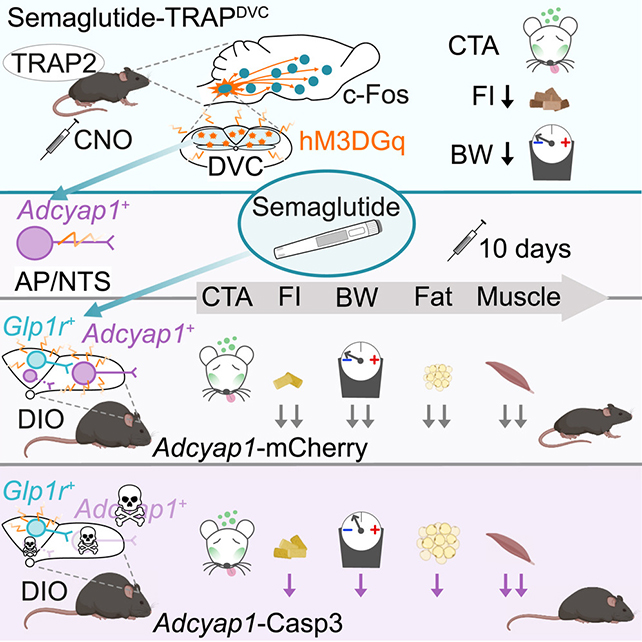Weight-loss drugs that mimic the effect of regulatory hormones on appetite and energy balance often come with a few rather uncomfortable side effects.
Semaglutide is what's known as a GLP-1 receptor agonist, meaning it activates the receptors of the GLP-1 (glucagon-like peptide-1) hormones that regulate blood sugar and appetite in our own bodies. Activation of these receptors on other cells can trigger a range of other outcomes, both positive and negative.
Researchers from the University of Gothenburg in Sweden have now identified a network of neurons in the brains of mice that specifically deliver the same health benefits of semaglutide medications like Ozempic and Wegovy without the risk of nausea and loss of lean body mass that can come with them.
Further study of these nerves – the Adcyap1+ neurons, to give them their technical name, in the dorsal vagal complex part of the brain – could lead to treatments with effects similar to semaglutide without its wide-ranging side effects.
"This suggests that these nerve cells control the beneficial effects of semaglutide," says neuroscientist Júlia Teixidor-Deulofeu, from the University of Gothenburg.
"We have therefore identified a specific group of nerve cells that is necessary for the effects that semaglutide has on weight and appetite, but which does not appear to contribute to any significant extent to side effects such as nausea."

The scientists gave doses of semaglutide to mice and searched for specific brain cells that became active as a consequence. That led them to the Adcyap1+ neurons in the stem of the brain.
By artificially activating the cells in further tests, the researchers produced a loss of appetite and weight loss in the mice. When the cells were destroyed, there was little impact on weight when semaglutide was administered, even while the drug's side effects remained.
Add all of that up, and we may be able to design treatments with all the pros of semaglutide and not so many of the cons.
"If we can target the treatment there, we may be able to maintain the positive effects while reducing side effects," says Teixidor-Deulofeu.
As these nerve cells have only just been identified – and only in mice – any potential treatments are still a long way off. What's more immediate is the insight into how semaglutide works on the brain.
While the drug's effects have been well documented, it's been less clear exactly how and why it's working. This research gives us more insight into that aspect of semaglutide, so its applications can be further refined.
"Semaglutide and other GLP-1 receptor agonists are currently being prescribed to more and more people and are also being investigated for other potential indications such as substance use disorders and neurodegenerative diseases," says neuroscientist Linda Engström Ruud from the University of Gothenburg.
"It is important to understand how these drugs actually work. The better we understand this, the greater the opportunity we have to improve them."
The research has been published in Cell Metabolism.
